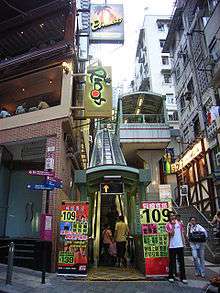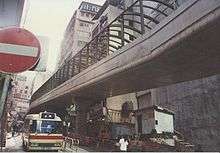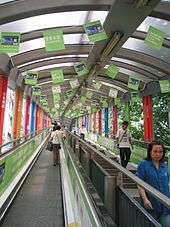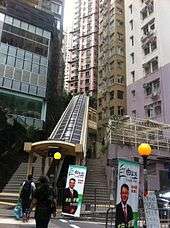Central–Mid-Levels escalator and walkway system
Coordinates: 22°17′1.19″N 114°9′17.40″E / 22.2836639°N 114.1548333°E
| Central–Mid-Levels escalator and walkway system | |||
 Elgin Street entrance. | |||
| Chinese | 中環至半山自動扶梯 | ||
|---|---|---|---|
| |||
The Central–Mid-Levels escalator and walkway system in Hong Kong is the longest outdoor covered escalator system in the world. Engineered by French company Constructions industrielles de la Méditerranée the entire system covers over 800 metres (2,600 ft) in distance and elevates over 135 metres (443 ft) from bottom to top.[1] It was constructed in 1993 to provide a better commute by linking areas within the Central and Western District on Hong Kong Island.[2]
History


The proposal of the project began in November 1987, when the Government faced the problem of increasing vehicular traffic in Mid-Levels.[3] It was an "outside the box" transportation solution generated by a group of civil engineers working for P & T Architects & Engineers Ltd.
In operation since 1993, it cost HK$240 million (US$30 million) to build although it was originally approved in March 1990 with a budget of HK$100m and annual maintenance costs of $950,000.[4] Since its conception in March 1987, its scope and its budget were considerably increased.[5]
In November 1996, the Director of Audit issued a report which criticised the project as being a "white elephant", saying that it failed to achieve the primary objective of reducing traffic between the Mid-Levels and Central, as well as over-running its budget by 153%. The Highways Department's poor handling of the project was the main reason for having five cost revisions of the project since the budget had been initially approved. The Director of Audit blamed it for failing to address the risks and complexities associated with the project in the pre-tender estimates, and costs rising because of delays.[6] Land resumption costs were also underestimated by $74 million (or 180%). The report also points out that a "before-and-after" study by the Transport Department indicated no obvious reduction in traffic congestion.[6]
The Transport Department conducted patronage surveys for the entire system in 2005 and 2010. In 2005, the system saw about 54,000 daily pedestrian trips. This grew to 85,000 trips in 2010. The department noted that the escalator has relieved demand for public transport, but has not led to many motorists giving up driving or reduced traffic congestion, in line with the traffic planning principle of induced demand.[7] The Transport Department will conduct another usage survey in 2016.[7]
Since the escalator system opened, most pedestrians gather at the elevated level; previously they gathered at the street level. This has opened up large tracts of intermediate levels above ("SoHo") and below ("NoHo") Hollywood Road, to pedestrians and commerce. Many restaurants have opened around all the elevated level, in the first or second floors of buildings already present.
The system is scheduled for refurbishment in phases starting in 2017.[7]
Description



Hong Kong Island is dominated by steep, hilly terrain, which makes it the home of some rather unusual methods of transport up and down the slopes. It was featured on the CNN website as one of the coolest commutes in the world in March 2015.[8]
Since it was officially opened to the public on 15 October 1993, the escalator system has played a very important role in pedestrianising the Western District. It links Queen's Road Central in Central with Conduit Road in the Mid-Levels, passing through narrow streets. The daily traffic exceeds 85,000 people,[7] although originally forecast 27,000. At Queen's Road Central, the Central–Mid-Levels escalators system is connected through Central Market to the Central Elevated Walkway, an extensive footbridge network covering the Central area.
The escalator system is 800 metres (2,600 ft) long with a vertical climb of 135 metres (443 ft). The total travel time is twenty minutes, but most people walk while the escalator moves to shorten their trip. Due to the geographical situation, the same distance is equivalent to several miles of zigzagging roads if travelling by car. It consists of 18 escalators and three inclined moving walkways. According to Guinness World Records, these escalators together form the longest outdoor covered escalator system.[9][10]
The one-way escalators and moving walkways run downhill from 6 a.m. to 10 a.m. and then uphill from 10 a.m. to midnight daily. Apart from serving as a method of transporting, the system is also a tourist attraction and has restaurants, bars, and shops lining its route. There is an entrance and exit on each road it passes, often on both sides of the road.
Bisecting streets
The system runs through the whole length of Cochrane Street (named for Rear Admiral Thomas Alexander Cochrane)[11] between Queen's Road Central and Hollywood Road. Then it runs along the entire length of a ladder street, Shelley Street.
The whole system bisects the following streets / roads:
- Des Voeux Road Central (德輔道中)
- Queen's Road Central (皇后大道中)
- Stanley Street (士丹利街)
- Wellington Street (威靈頓街)
- Gage Street (結志街)
- Lyndhurst Terrace (擺花街)
- Hollywood Road (荷里活道)
- Staunton Street (士丹頓街) - Soho area
- Elgin Street (伊利近街)
- Caine Road (堅道)
- Mosque Street (摩羅廟街)
- Mosque Junction (摩羅廟交加街)
- Robinson Road (羅便臣道)
- Conduit Road (干德道)
As film location
The Central–Mid-Levels escalators have been used as filming locations for several films, including:
- Chungking Express (1994). Director Wong Kar-wai stated: "That interests me because no one has made a movie there. When we were scouting for locations we found the light there entirely appropriate."[12]
- Chinese Box (1997). Set in the months immediately preceding the 1997 handover of Hong Kong, the flat-cum-office of the main character John (Jeremy Irons) is located directly at the Central–Mid-Levels escalators.
- The Batman film The Dark Knight (2008). Filming took place there 6–11 November 2007.
See also
References
- ↑ Rory Boland. "Hong Kong's Central-Mid Levels Escalator - The Longest in the World". About.com. Retrieved 3 November 2009.
- ↑ Anne Gold (6 July 2001). "Hong Kong's Mile-Long Escalator System Elevates the Senses : A Stairway to Urban Heaven". New York Times. Retrieved 3 November 2009.
- ↑ Brian Wong,HK's lofty plan for world's longest moving walkway is a step nearer, South China Morning Post, 4 November 1987
- ↑ "Escalator link to Central approved" (PDF). The Standard. 17 March 1990. Retrieved 19 December 2006.
- ↑ "Mid Levels link rises to $100m" (PDF). South China Morning Post. 17 March 1990. Retrieved 19 December 2006.
- 1 2 Yonden Lhatoo, Escalator 'a costly white elephant', The Standard, 6 November 1996
- 1 2 3 4 "LCQ10: Hillside escalator links and elevator systems". Legislative Council. 16 December 2015.
- ↑ http://www.okay.com/en/property-news/CNN-ranks-HK-Mid-Levels-Escalator-as-one-of-the-worlds-7-coolest-commutes/293?nid=59
- ↑ "Stairway to urban heaven", South China Morning Post, 11 July 2011
- ↑ McCarthy, Michael (26 June 2009). "Hong Kong escalator stairway to the skies". The Vancouver Sun. Vancouver Courier.
- ↑ Yanne, Andrew; Heller, Gillis (2009). Signs of a Colonial Era. Hong Kong University Press. p. 86. ISBN 978-962-209-944-9.
- ↑ J. D. Lafrance, "Cinematic Pleasures: Chungking Express", Erasing Clouds 23 (2004)
External links
| Wikimedia Commons has media related to Central-Mid-Levels escalators. |
- Labyrinth in the Air - TV program by the Radio Television Hong Kong on the Central–Mid-levels escalators and the related Central Elevated Walkway. (video archive)
- BBC Close-up, brief video on the importance of the escalators